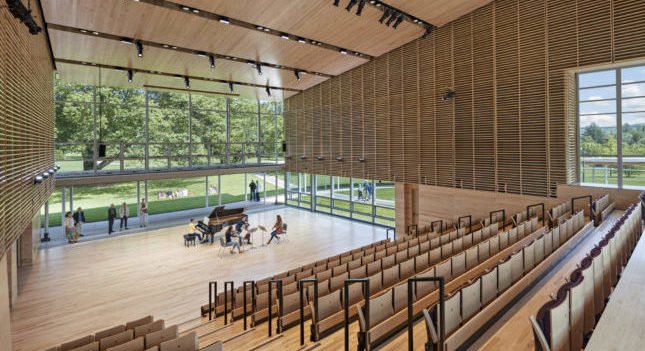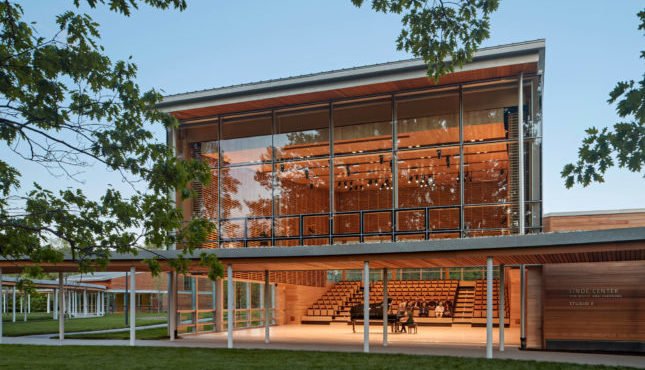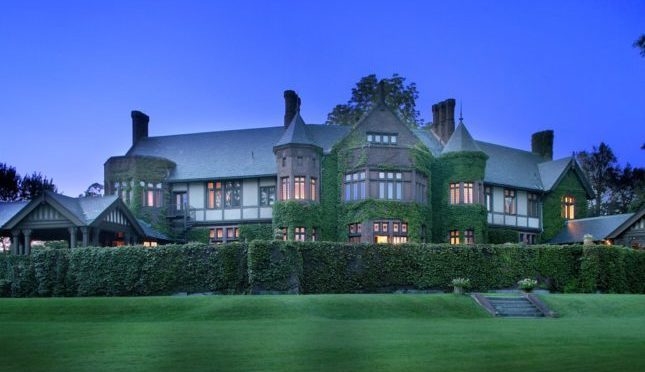Lenox, the bucolic Berkshires town known for its Gilded Age mansions, leafy hiking paths and world-class cultural institutions, is about to discover whether its lofty abundance will be too much of a good thing, as new resorts and increased arts programming are poised to bring year-round travel to what has historically been a genteel summer destination.

The town, which has just 4,700 year-round inhabitants but swells to as many as 20,000 residents in the summer, is anticipating major changes to its arts and hospitality offerings. The most significant: This summer’s inauguration of the $40 million Linde Center for Music and Learning at Tanglewood, the 82-year-old summer home of the Boston Symphony Orchestra, and long the driver of the Berkshires’ cultural economy.

“It’s a lot for a town with one road in and one road out. I’d never want Lenox to be like the Hamptons, or for the Berkshires to get gridlocked like Cape Cod, but I’m not worried about it. I have faith in town leaders to think about the next generation and not the next election,” says state representative William “Smitty” Pignatelli, 59, a third-generation resident who recalls the Lenox of his youth as a sleepy bedroom community, revolving around employment in nearby Pittsfield. Lenox was then primarily residential, and its small commercial strip featured an unprepossessing amalgam of a car dealership and two gas stations.
The main local employers were the GE plant in Pittsfield and the paper mills that dotted the Berkshires. As they closed in the 1970s, Lenox began marketing its cultural foundations: Tanglewood, the Jacob’s Pillow Dance Festival, the Shakespeare & Company theater troupe. Lenox also passed extremely strict zoning laws, creating a jewel-like Main Street of art galleries, cafes, farm-to-table restaurants, and more recently, boutique inns and worldly shops carrying organic Australian skincare and dresses from niche designers in Paris and Milan.
Lenox was the inland Newport for the Westinghouses, JP Morgan, the Vanderbilts, the Rockefellers.
“I think Lenox was ahead of that curve in the cultural economy, because of the Gilded Age. Lenox was the inland Newport for the Westinghouses, JP Morgan, the Vanderbilts, the Rockefellers,” Pignatelli says. “We were always a getaway for wealthy New Yorkers, and we continue to be.”

Today, that getaway’s becoming increasingly compelling.

The new Linde Center, a four-building, 6,000-square-foot complex designed by William Rawn Associates, will house the Tanglewood Learning Institute (TLI). Positioning itself as a year-round, multidisciplinary arts destination, TLI will offer master classes, artist lectures and screenings in partnership with the Berkshire International Film Festival and art courses with IS183 Art School of the Berkshires. Among the center’s debut offerings: a talk on nation building by former secretary of state Madeleine Albright, timed to a performance of Giuseppe Verdi’s Requiem; interactive master classes with the Juilliard String Quartet and a discussion with performance artist Meow Meow.
“It’s a sea change for both the Boston Symphony and for the Berkshires. We’re really bringing people together for shared human experiences, many of which surround some sort of creative expression, but not exclusively music,” says TLI director Sue Elliott. “We’re providing a closer look at the artistic process, closer interaction between artists and audience members.”
Tanglewood, along with the growing popularity of the Mass MoCA contemporary art museum in North Adams, and the Mahaiwe Performing Arts Center in nearby Great Barrington, will increase demand for hotel rooms, a need eagerly anticipated by both established resorts and newcomers.
There’s only going to be more music, more film, more dance.

“I think a lot of the old properties are stuck in a 20-to-30-year-old view of what people want when they come to Lenox,” says textile entrepreneur Annie Selke, who opened the chic 33 Main, a nine-room bed and breakfast housed in an 1830 building that was once home to two Astor sisters, in August 2017. “I’m interested in adding more hotel rooms and bringing the level of hospitality up. With Tanglewood, Jacob’s Pillow and the Berkshire International Film Festival, there’s a lot happening. There’s only going to be more music, more film, more dance.”
Selke, a Berkshires native who lived in San Francisco and New York before launching her Lenox-based interior decor companies Pine Cone Hill and Dash & Albert, says she’s delighted by the town’s new dynamism and unworried the increasing crowds will change the local character.
“It might become what the Hamptons were 40 years ago, before the Russian oligarchs, but I don’t think it will attract people who want to be flashy. It’s the country, it’s muddy and can be buggy. It’s not a stiletto kind of place,” she says. “People who come here love theater, music, nature, food. Lenox draws people who have less vapid taste.”

Less vapid, perhaps, but still enamored of luxury, and they’ll find it at old favorites like the Blantyre, a Relais & Chateaux hotel in a 1902 estate, which is re-energized with a new owner, a Dom Perignon Champagne salon, a young female sommelier and a recovered china collection—including President Lincoln’s personal china from the White House. Blantyre’s also hosting black tie, butler-served picnics at Tanglewood, with china, linens, crystal and candelabras. The estimable Wheatleigh, built in 1893 by financier Henry H. Cook and modeled on a 16th-century Florentine palazzo, provides what may be Lenox’s poshest accommodations, its 19 rooms and suites overlooking 22 acres designed by Gilded Age landscape architect Frederick Law Olmsted.

By early 2020, the 380-acre Cranwell Resort—a former home of Harriet Beecher Stowe’s family, and then a Jesuit boarding school counting Ted Kennedy as an alum—will become two hotels: Wyndhurst Manor & Club and Miraval, a spa-focused wellness brand owned by Hyatt, which is spending $80 million to transform the property. Miraval’s arrival adds a new wellness option to old stalwarts like the Kripalu Center for Yoga & Health. Miraval’s main competitor, Canyon Ranch, has been in Lenox since 1989 and distinguishes itself for its medical approach, focusing on preventative care and what it calls “integrated holistic wellness.”

Last year, Mindi Morin, Canyon Ranch’s general manager, oversaw the addition of 19 condo units, with sale prices ranging from $1.5 to $3 million. Only four are left.
People used to joke that Massachusetts stops at the Cape.
“People used to joke that Massachusetts stops at the Cape. We hear from our guests, ‘We usually just go to the Cape. We hadn’t realized you were so close to New York or Boston.’ All of the new cultural and hospitality options will only help us,” Morin says.
Lenox’s new offerings are prompting a renewed look at transportation alternatives.

“A lot of people are coming from Manhattan, and we want to build our young tourists. They don’t drive. They get on trains and go to the Hamptons and Hudson,” says Doris Barsauskas, a former Princeton, N.J.-based Liz Claiborne executive who opened the shop MacKimmie Co. five years ago, selling luxurious imported blankets, accessories and other textiles. Barsauskas, who says that she still pinches herself at her good fortune to live in Lenox, is eager to share the town. “We want them to come here.”
To that end, Amtrak, MassDOT and local officials are exploring adding a Berkshire Flyer train, a weekend-only service between Pittsfield, Massachusetts and New York’s Penn Station, possibly by next summer. Pignatelli’s lobbying the Peter Pan bus company to create an express bus from Pittsfield to Manhattan (it currently runs a local service). A third option, adding a north-south rail from Pittsfield to New York, rests on Connecticut’s cooperation, which Pignatelli notes hasn’t been forthcoming.
As Lenox confronts a new phase in its evolution, the locals remain sanguine, and largely unfazed by the future’s potential challenges.
“My grandfather came through Ellis Island and moved to Lenox to work on the great estates, and the wealthy people got here on the rail. One hundred years later, we’re still talking about great estates and the rail,” Pignatelli says. “The issues never change, only the faces.”






